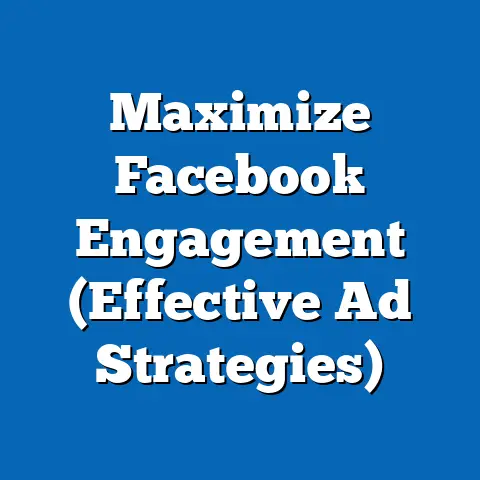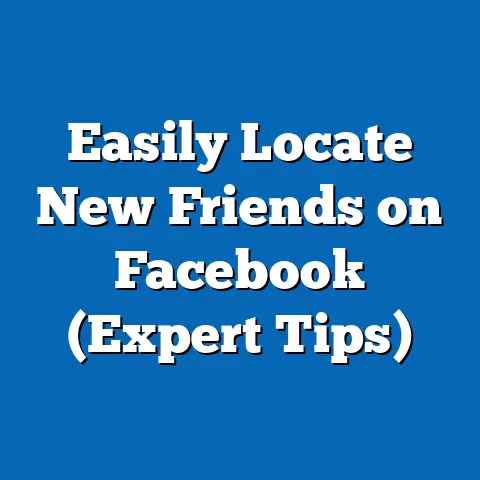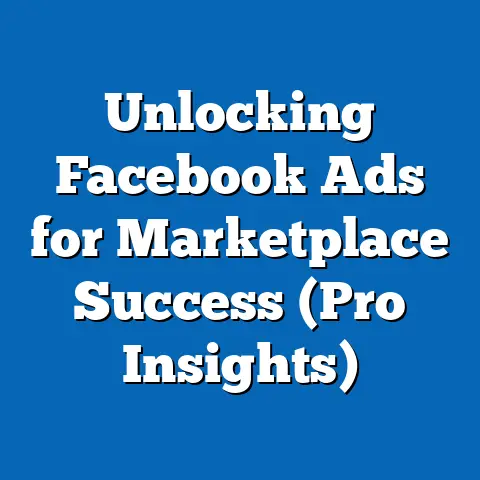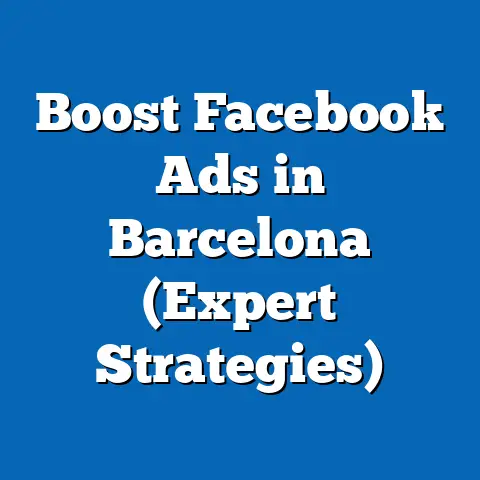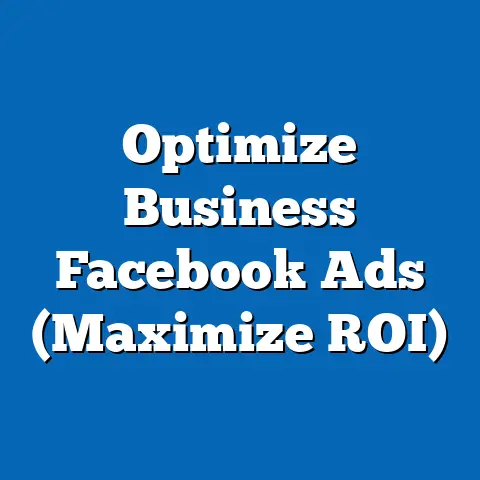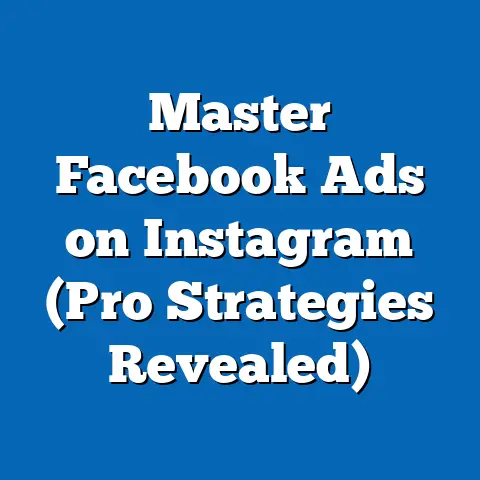Master Facebook Ad Length (Essential Tips for Success)
In today’s digital marketing world, Facebook advertising stands as a powerful tool for businesses of all sizes. With billions of active users, the platform offers unparalleled reach and targeting capabilities. However, the social media landscape is increasingly competitive, and user attention spans are shrinking. This is where the art and science of crafting the perfect Facebook ad come into play, and one of the most critical elements is ad length.
I’ve seen firsthand how even the most creative and visually stunning ads can fall flat if they’re too long, too short, or simply don’t get to the point quickly enough. Think of it like this: you have a few seconds to capture someone’s attention as they scroll through their feed. If your message is buried in a wall of text, you’ve already lost. On the other hand, a message that’s too cryptic or lacking in detail can also leave users confused and uninterested.
1. The Psychology Behind Ad Length
Understanding the psychology behind ad length is crucial for crafting effective Facebook ads. It’s not just about fitting your message into a limited space; it’s about understanding how people consume information on social media and how their brains process different types of content.
The Attention Span of Social Media Users
It’s no secret that attention spans are getting shorter, especially online. Studies have shown that the average human attention span has decreased significantly in recent years. On social media, this is even more pronounced. Users are constantly bombarded with information, and they quickly scroll past anything that doesn’t immediately grab their attention.
I’ve observed this firsthand in my own social media habits. I often find myself mindlessly scrolling, barely registering the content I’m seeing. It’s only when something truly stands out – a captivating image, a compelling headline, or a concise message – that I stop and take notice.
According to a study by Microsoft, the average human attention span is now around eight seconds, shorter than that of a goldfish. While this statistic is often cited, the underlying point is clear: you have very little time to make an impression on your audience. This means your ad needs to be clear, concise, and immediately engaging.
How Ad Length Influences Engagement and Conversion Rates
Ad length can have a significant impact on both engagement and conversion rates. A study by HubSpot found that shorter Facebook ad copy (around 50-80 characters) tended to perform better in terms of engagement. This makes sense, as shorter copy is easier to read and digest quickly.
However, it’s not always about being as short as possible. Sometimes, a longer ad can be more effective, especially if you’re trying to tell a complex story or explain a unique product feature. The key is to find the right balance.
I remember working on a campaign for a new fitness app. Initially, we tried short, punchy ads that focused on the app’s core benefits. While these ads generated some clicks, they didn’t lead to many conversions. We then experimented with longer ads that explained the app’s unique features and how it differed from other fitness apps. These longer ads, while requiring more of the user’s attention, ultimately led to a higher conversion rate.
The ideal ad length depends on several factors, including your target audience, the type of product or service you’re promoting, and the overall goal of your campaign.
Psychological Principles in Optimal Ad Lengths
Several psychological principles can help you determine the optimal length for your Facebook ads:
- The Zeigarnik Effect: This principle suggests that people remember incomplete or interrupted tasks better than completed ones. You can use this to your advantage by creating ads that pique curiosity and encourage users to click to learn more.
- The Von Restorff Effect: Also known as the isolation effect, this principle states that items that stand out from their surroundings are more likely to be remembered. You can use this by making your ad visually distinct or using unexpected language.
- The Reciprocity Principle: People tend to feel obligated to reciprocate when someone does something for them. You can offer a free ebook, discount code, or other valuable resource in your ad to encourage engagement.
By understanding these psychological principles, you can craft ads that are not only the right length but also highly effective at capturing attention and driving results.
Key Takeaway: Understanding the psychology behind ad length is essential. Keep your message concise, engaging, and relevant to capture attention and drive conversions. Experiment with different lengths to find what works best for your audience.
2. Understanding Facebook’s Algorithm and Ad Length
Facebook’s algorithm is a complex and ever-changing system that determines which ads are shown to which users. Understanding how the algorithm works and how it relates to ad length is crucial for maximizing the visibility and effectiveness of your campaigns.
How Facebook’s Algorithm Impacts Ad Visibility
Facebook’s algorithm aims to provide users with the most relevant and engaging content possible. This means that ads are constantly being evaluated and ranked based on various factors, including:
- Relevance Score: This metric measures how relevant your ad is to your target audience. A higher relevance score means your ad is more likely to be shown to users.
- Estimated Action Rate: This predicts how likely users are to take a desired action (e.g., click, like, share) after seeing your ad.
- Ad Quality: This assesses the overall quality of your ad, including its visual appeal, copy, and landing page experience.
Ad length can indirectly impact these factors. For example, if your ad copy is too long and rambling, users are less likely to read it and engage with your ad. This can lower your relevance score and estimated action rate.
The Role of Ad Length in Determining Ad Relevance and Quality Score
Ad length plays a critical role in determining ad relevance and quality score. Facebook favors ads that are clear, concise, and easy to understand. This means that shorter, more focused ads often perform better.
I’ve seen this play out in my own campaigns. I once ran two similar ads for the same product, one with a short, punchy headline and the other with a longer, more descriptive headline. The ad with the shorter headline consistently outperformed the other, even though the rest of the ad copy was nearly identical.
This doesn’t mean that you should always aim for the shortest possible ad. Sometimes, a longer ad can be more effective if it provides valuable information or tells a compelling story. However, you need to make sure that your longer ad is well-written, engaging, and easy to read.
Aligning Ad Length with Algorithmic Preferences
To align your ad length with algorithmic preferences, consider the following tips:
- Keep it concise: Get straight to the point and avoid unnecessary words or phrases.
- Use strong visuals: Pair your ad copy with eye-catching images or videos to grab attention.
- Target the right audience: Make sure your ad is shown to users who are likely to be interested in your product or service.
- Test different lengths: Experiment with different ad lengths to see what works best for your audience.
- Monitor your metrics: Track your ad’s performance and make adjustments as needed.
By following these tips, you can increase the visibility and effectiveness of your Facebook ads and improve your overall ROI.
Key Takeaway: Understanding Facebook’s algorithm and its preferences for concise and engaging ads is crucial. Optimize your ad length to improve relevance and quality scores, ultimately increasing visibility and performance.
3. Best Practices for Crafting Effective Facebook Ads
Crafting effective Facebook ads requires a combination of creativity, strategy, and attention to detail. Here are some best practices for determining the ideal length of your ads:
Recommended Character Limits for Different Ad Types
Facebook offers various ad formats, each with its own recommended character limits:
- Image Ads:
- Headline: 25 characters
- Primary Text: 125 characters
- Description: 30 characters
- Video Ads:
- Headline: 25 characters
- Primary Text: 125 characters
- Description: 30 characters
- Carousel Ads:
- Headline: 40 characters
- Description: 20 characters
- Headline: 25 characters
- Primary Text: 125 characters
- Description: 30 characters
- Headline: 25 characters
- Primary Text: 125 characters
- Description: 30 characters
- Headline: 40 characters
- Description: 20 characters
These character limits are just recommendations, and you can often exceed them. However, it’s generally a good idea to stay within these limits to ensure that your ad is displayed correctly on all devices and that your message is easy to read.
I’ve found that sticking to these limits forces me to be more concise and focused in my messaging. It’s a good exercise in distilling your message down to its most essential elements.
Concise Messaging and Clear Calls-to-Action
Concise messaging and clear calls-to-action are essential for effective Facebook ads. Your ad should quickly and clearly communicate what you’re offering and what you want users to do.
Avoid using jargon or overly technical language. Instead, use simple, straightforward language that everyone can understand. Your call-to-action should be clear and specific, telling users exactly what you want them to do (e.g., “Shop Now,” “Learn More,” “Sign Up”).
I often use A/B testing to experiment with different calls-to-action. For example, I might test “Get Started” versus “Try it Free” to see which one performs better.
Testing Different Ad Lengths for Specific Audiences
The ideal ad length can vary depending on your target audience. What works for one audience may not work for another. That’s why it’s important to test different ad lengths to see what resonates best with your specific audience.
Facebook’s A/B testing feature makes it easy to test different ad lengths. Simply create two versions of your ad, one with a shorter length and one with a longer length, and let Facebook run the test. After a few days, you can analyze the results and see which version performed better.
I’ve found that older audiences often respond better to longer, more detailed ads, while younger audiences tend to prefer shorter, more visually appealing ads. However, these are just general trends, and you should always test to see what works best for your specific audience.
Key Takeaway: Adhere to recommended character limits, prioritize concise messaging, and use clear calls-to-action. A/B test different ad lengths to identify what resonates best with your target audience and optimize for maximum engagement.
4. Case Studies: Successful Facebook Ads and Their Lengths
Analyzing successful Facebook ads and their lengths can provide valuable insights into what works and what doesn’t. Here are a few case studies to illustrate the importance of ad length:
Case Study 1: Dollar Shave Club
Dollar Shave Club is known for its humorous and engaging video ads. Their initial video ad, which went viral in 2012, was around 1 minute and 30 seconds long. While this might seem long for a social media ad, the video was so entertaining and well-produced that people were happy to watch it.
Key Takeaway: If you can create a truly engaging and entertaining video ad, you can get away with a longer length.
Case Study 2: Airbnb
Airbnb often uses short, visually appealing image ads to promote their listings. These ads typically feature a stunning photo of a unique property and a brief headline that highlights the key benefits of staying there. The ad copy is usually concise and to the point, focusing on the location, amenities, and price.
Key Takeaway: For visually driven products or services, a short, visually appealing ad with concise copy can be highly effective.
Case Study 3: HubSpot
HubSpot often uses longer, more informative ads to promote their marketing software. These ads typically include a detailed description of the software’s features and benefits, as well as a clear call-to-action. While these ads are longer than average, they target a specific audience of marketing professionals who are looking for detailed information.
Key Takeaway: If you’re targeting a niche audience that is looking for detailed information, a longer, more informative ad can be effective.
Lessons Learned
These case studies illustrate that there is no one-size-fits-all approach to ad length. The ideal length depends on your product or service, your target audience, and your overall marketing goals. However, here are a few key lessons that can be applied to any Facebook ad campaign:
- Know your audience: Understand what your audience is looking for and tailor your ad length accordingly.
- Focus on value: Make sure your ad provides value to your audience, whether it’s entertainment, information, or a special offer.
- Test and optimize: Experiment with different ad lengths and track your results to see what works best.
Key Takeaway: Analyze successful ad campaigns to understand how ad length contributes to their success. Tailor your ad length to your specific audience and always prioritize providing value.
5. Tools and Resources for Ad Length Optimization
Optimizing your ad length requires more than just intuition. Fortunately, there are several tools and resources available to help you analyze your ad performance and make informed decisions about ad length:
Analytics Tools for Measuring Ad Performance
- Facebook Ads Manager: Facebook’s built-in analytics tool provides detailed data on your ad performance, including reach, impressions, clicks, conversions, and cost per result. You can use this data to track how different ad lengths are performing and identify areas for improvement.
- Google Analytics: If you’re driving traffic to your website from your Facebook ads, you can use Google Analytics to track user behavior on your site. This can help you understand how your ads are influencing conversions and revenue.
- Third-Party Analytics Tools: Several third-party analytics tools, such as Hootsuite and Buffer, offer more advanced analytics and reporting features. These tools can help you track your social media performance across multiple platforms and identify trends and patterns.
I personally rely heavily on Facebook Ads Manager for monitoring my campaigns. The ability to segment data and track key metrics like click-through rate (CTR) and conversion rate is invaluable.
Staying Updated on Facebook Ad Guidelines and Best Practices
Facebook’s advertising guidelines and best practices are constantly evolving. To stay up-to-date, consider the following resources:
- Facebook Business Help Center: This is the official source for information on Facebook’s advertising policies and best practices.
- Facebook Marketing Partners: Facebook partners with various marketing agencies and technology providers to offer specialized services and expertise.
- Industry Blogs and Publications: Several industry blogs and publications, such as Social Media Examiner and MarketingProfs, regularly publish articles on Facebook advertising.
- Online Courses and Webinars: Several online courses and webinars offer in-depth training on Facebook advertising.
Key Takeaway: Utilize analytics tools to measure ad performance and track key metrics related to ad length. Stay informed about Facebook’s evolving guidelines and best practices to ensure your ads remain compliant and effective.
6. Future Trends in Facebook Ad Length
The future of Facebook advertising is likely to be shaped by several emerging trends, including artificial intelligence, machine learning, and changing user behaviors. Here’s a glimpse into what the future might hold for ad length:
The Impact of Emerging Technologies
- Artificial Intelligence (AI): AI is already being used to automate various aspects of Facebook advertising, such as ad targeting and optimization. In the future, AI could be used to automatically generate ad copy and visuals, tailoring the ad length to the specific audience and context.
- Machine Learning (ML): Machine learning algorithms can analyze vast amounts of data to identify patterns and trends. In the future, ML could be used to predict the optimal ad length for different audiences and campaigns, taking into account factors such as demographics, interests, and past behavior.
I believe AI and ML will play an increasingly important role in ad creation and optimization. We may see tools that automatically generate multiple ad variations with different lengths and then use machine learning to determine which ones perform best.
Changing User Behaviors
- Mobile-First: More and more users are accessing Facebook on their mobile devices. This means that ads need to be optimized for mobile viewing, with shorter ad lengths and clear calls-to-action.
- Video Consumption: Video consumption is on the rise, and video ads are becoming increasingly popular. However, users’ attention spans are even shorter for video ads, so it’s important to keep your videos concise and engaging.
- Personalization: Users are becoming increasingly accustomed to personalized experiences. In the future, ads may be tailored to individual users based on their interests, preferences, and past behavior. This could involve using dynamic ad copy and visuals to create a more relevant and engaging experience.
Key Takeaway: Prepare for future trends in Facebook advertising, including the increasing use of AI and machine learning for ad optimization. Adapt to changing user behaviors, such as the growing popularity of mobile devices and video consumption, by optimizing ad lengths for these platforms.
Conclusion
Mastering Facebook ad length is a critical factor in achieving advertising success. By understanding the psychology behind ad length, aligning with Facebook’s algorithm, following best practices, analyzing successful case studies, utilizing available tools, and staying informed about future trends, you can craft ads that capture attention, drive engagement, and generate results.
I’ve shared my experiences and insights throughout this guide, and I encourage you to experiment with different ad lengths and strategies to find what works best for your specific audience and goals. Remember, the social media landscape is constantly evolving, so it’s important to stay flexible and adapt your approach as needed.
Ultimately, the key to success on Facebook is to create ads that are valuable, relevant, and engaging. If you can do that, you’ll be well on your way to achieving your marketing objectives. So, go out there, experiment, and have fun! Your next breakthrough ad campaign might just be a few characters away.

